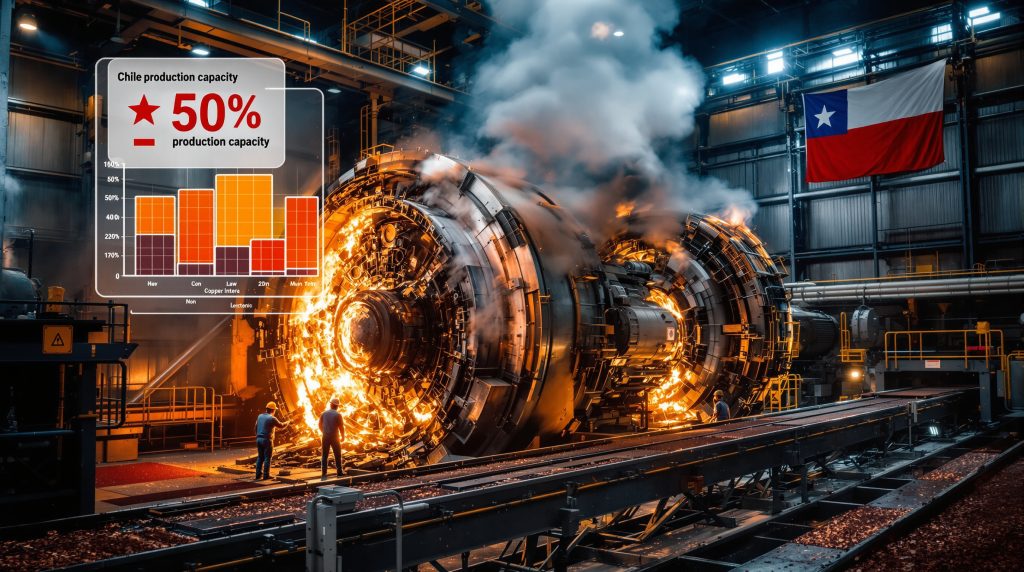How Do Ball Mill Motor Failures Impact Mining Operations?
Mining operations rely heavily on continuous processing to maintain production targets and profitability. Ball mill motor failures represent one of the most disruptive equipment breakdowns in mineral processing, creating ripple effects throughout the entire operation. When these critical components fail, the consequences extend far beyond the immediate mechanical issue.
Ball mills typically consume between 50-70% of a mineral processing plant's total energy, making them both crucial and costly components in the production chain. The motors driving these massive grinding units operate under extreme conditions, including high torque loads, dust exposure, and minimal scheduled downtime.
The financial impact of ball mill failures is substantial. Replacement costs for large ball mill motors range from $500,000 to $2 million depending on size and specifications, while the revenue losses from production interruptions can reach millions of dollars per day for major operations. These unexpected failures force operations to either run at reduced capacity or halt production entirely while repairs or replacements are implemented.
Beyond immediate production losses, motor failures create logistical challenges due to the specialized nature of the components and their typically remote locations. Furthermore, replacement parts often require extended lead times, and the technical expertise needed for proper installation may not be immediately available at remote mining sites.
What Happened at the Mantoverde Mine in Chile?
Timeline of the Motor Failure Events
The Mantoverde copper mine in Chile experienced a sequence of equipment failures that significantly impacted its production capabilities:
- August 24, 2025: Initial failure of one of two ball mill electrical drive motors
- Following days: Replacement with available on-site spare motor
- Shortly after replacement: Second ball mill drive motor failed
- No additional spare motors available on-site
- Current status: Operating at approximately 50% capacity
This cascading failure scenario represented a worst-case situation for the operation, as the site had prepared for a single motor failure with an on-site spare but did not have sufficient redundancy for consecutive failures.
Production Impact Assessment
The dual motor failures created substantial operational challenges with quantifiable impacts:
- Estimated production loss: 3,000-4,000 metric tons of copper concentrate
- Duration of reduced operations: Approximately 4 weeks
- Current operational capacity: Running at roughly 50% of normal production
For Mantoverde, owned by Capstone Copper Corporation (TSX: CS, NASDAQ: CSTL), this production disruption comes at a time when copper prices remain strong, amplifying the financial impact. The mine, located in Chile's Atacama Region approximately 50km east of Copiapó, represents a significant asset in the company's portfolio.
How Is Capstone Copper Managing the Crisis?
Immediate Response Strategies
Capstone implemented several tactical responses to minimize the impact of the consecutive motor failures:
- Rapid deployment of the available spare motor after the initial failure
- Activation of ball mill bypass mode to maintain partial production
- Rescheduling of planned maintenance from late September to coincide with the forced downtime
- Initiation of a root cause investigation to prevent future failures
The company's crisis management approach demonstrates a well-structured contingency plan designed to maintain operational continuity while addressing the technical challenges.
Technical Workarounds Implemented
The mine's technical team leveraged existing plant capabilities to maintain partial operations despite the equipment failure:
- Utilization of the plant's built-in ball mill bypass configuration
- Maintenance of approximately 50% of normal production capacity
- Leveraging staff familiarity with bypass operating procedures
- Focus on optimizing the reduced-capacity production flow
This operational flexibility highlights the importance of designing processing facilities with redundancy and bypass capabilities to mitigate the impact of critical equipment failures.
What Are the Financial Implications of Such Equipment Failures?
Direct Production Losses
The immediate financial impact of Mantoverde's motor failures includes significant production losses during a period of strong copper market conditions:
| Impact Category | Estimated Loss |
|---|---|
| Copper concentrate production | 3,000-4,000 metric tons |
| Operational capacity | Reduced by approximately 50% |
| Downtime duration | Approximately 4 weeks |
With copper concentrate prices fluctuating between $7,000-$9,000 per metric ton in recent markets, the direct revenue impact from this production loss could range from $21 million to $36 million, depending on current pricing and exact production volumes.
Hidden Costs and Long-term Considerations
Beyond the obvious production losses, equipment failures create additional financial burdens that aren't immediately visible on balance sheets:
- Emergency procurement costs for replacement parts often carry premium pricing
- Potential overtime labor expenses during crisis management and repair phases
- Supply chain disruptions for downstream customers can damage long-term relationships
- Increased maintenance scrutiny and preventive measures going forward add operational costs
- Insurance premium implications if failures become recurring
Mining companies must consider these hidden costs when evaluating the true financial impact of equipment failures and when calculating the return on investment for preventive maintenance programs and redundancy strategies.
How Common Are Ball Mill Motor Failures in Mining Operations?
Critical Failure Points in Processing Equipment
Ball mills represent one of the most critical components in mineral processing, operating under conditions that create multiple potential failure points:
- High-power electrical motors operate continuously under extreme mechanical stress
- Abrasive dust infiltration compromises electrical insulation and cooling systems
- Vibration from grinding operations transfers to motor mountings and bearings
- Ambient conditions in processing facilities often include heat, humidity, and corrosive elements
- Replacement parts for specialized mining equipment typically have extended lead times
These challenging operating conditions create an environment where motor failures, while not routine, remain a persistent risk for even the best-maintained operations.
Industry-Wide Reliability Challenges
The mining sector faces ongoing challenges with equipment reliability that extend beyond any single operation:
- Processing equipment typically operates 24/7 with minimal scheduled downtime
- Remote locations complicate rapid parts delivery and specialized technical support
- Harsh operating environments accelerate wear on electrical components and insulation
- Increasing mineral hardness in many deposits places greater demands on grinding equipment
- Industry-wide skill shortages limit access to experienced maintenance specialists
While comprehensive industry-wide statistics on ball mill motor failure rates aren't publicly available, mining equipment manufacturers and maintenance service providers report that grinding circuit components represent among the highest-risk elements in processing plants.
What Preventive Measures Can Mines Implement?
Spare Parts Management Strategies
The Mantoverde incident highlights the critical importance of comprehensive spare parts strategies:
- Critical spares inventory management based on detailed failure risk assessment
- Stocking redundant components for high-consequence equipment
- Vendor partnerships for expedited emergency parts procurement
- Regional parts sharing agreements with other operations when possible
- Regular review and updating of critical spares inventories based on equipment performance data
Effective spare parts management requires balancing the capital investment in inventory against the potential production losses from extended downtime.
Predictive Maintenance Technologies
Modern mines increasingly adopt advanced monitoring approaches to detect potential failures before they occur:
- Real-time motor performance monitoring systems tracking electrical parameters
- Vibration analysis for early detection of developing bearing issues
- Thermal imaging to identify hotspots before catastrophic failure
- Oil analysis to detect metal particles indicating internal wear
- Motor current signature analysis to identify electrical anomalies
These predictive technologies create a preventive maintenance approach that can significantly reduce unplanned downtime by identifying deteriorating conditions before they lead to complete failures.
Who Supplied the Equipment for the Mantoverde Processing Plant?
Key Equipment Providers
The Mantoverde processing facility relies on equipment from major mining technology suppliers:
- Plant design: Ausenco engineered the processing facility
- Primary equipment: FLSmidth supplied most major components in 2022
- Critical equipment installed includes:
- Primary gyratory crusher
- SAG mill and ball mill
- Traditional flotation cells and column cells
- Thickeners, cyclones, and pumps
These global equipment suppliers represent the standard bearers for quality in mineral processing equipment, highlighting that even with top-tier equipment, operational failures remain a risk that must be managed.
Equipment Selection Considerations
Mining operations must balance several factors when selecting processing equipment:
- Operational reliability track record of suppliers
- Local service support capabilities
- Spare parts availability and lead times
- Integration compatibility with existing systems
- Total cost of ownership including energy efficiency
While initial capital costs often drive equipment selection decisions, the Mantoverde incident illustrates the importance of considering maintainability, spare parts availability, and redundancy options in the equipment selection process.
What Is the Broader Context of the Mantoverde Operation?
Mine Overview and Significance
Mantoverde represents an important copper production asset in Chile's mining landscape:
- Location: Northern Chile, a premier global copper mining region
- Operation type: Open-pit mine with sulphide copper production
- Owner: Capstone Copper, following the merger with Mantos Copper
- Strategic importance: Key producer in Chile's copper industry
The operation contributes to Chile's position as the world's leading copper producer, making disruptions at Mantoverde relevant to global copper supply considerations and commodity price impacts.
Ongoing Development Projects
Despite the current challenges, Mantoverde continues to develop for future production:
- The operation is undergoing significant expansion initiatives
- Investments focus on increasing production capacity and efficiency
- Long-term outlook remains positive despite short-term disruptions
- Chile's copper mining sector faces challenges including water access and energy costs
These development projects represent the mining industry's cyclical nature, where current operations fund future expansions while managing the operational challenges inherent in resource extraction and processing.
How Do Mining Companies Recover from Such Operational Disruptions?
Production Recovery Planning
Effective recovery from equipment failures requires comprehensive planning beyond the immediate repair:
- Phased restart procedures to prevent secondary failures when returning to full operation
- Accelerated maintenance during forced downtime to address other potential issues
- Production catchup strategies once full capacity is restored
- Supply chain communication to manage customer expectations during reduced output periods
These recovery strategies aim to minimize the total impact duration while ensuring the restored operations remain stable and reliable.
Operational Resilience Improvements
Forward-thinking mining operations use disruptions as catalysts for improvement:
- Post-incident analysis to identify systemic vulnerabilities in equipment and procedures
- Review of critical spares policies and inventory levels
- Evaluation of equipment redundancy requirements
- Enhancement of condition monitoring programs
- Training of personnel on alternative operating modes and emergency responses
These resilience improvements transform operational disruptions from pure losses into opportunities for strengthening the operation against future challenges, often leading to industry innovation trends and improved practices.
What Lessons Can the Mining Industry Learn from This Incident?
Critical Equipment Redundancy
The Mantoverde case highlights important industry lessons:
- The value of maintaining adequate spares for critical equipment extends beyond single-failure scenarios
- Importance of operational flexibility through bypass capabilities and alternative processing configurations
- Benefits of cross-trained staff familiar with alternative operating modes during equipment failures
- Need for robust emergency response protocols that include supply chain communication
These lessons apply across the mining sector regardless of commodity, processing method, or geography.
Industry Best Practices
Leading mining operations implement several strategies to prevent similar situations:
- Regular reliability-centered maintenance assessments to identify critical failure points
- Strategic partnerships with original equipment manufacturers for technical support
- Investment in condition monitoring technologies that provide early failure warnings
- Development of comprehensive contingency plans for various equipment failure scenarios
- Regular testing of bypass systems and alternative operating configurations
These best practices represent the mining industry's evolution toward greater operational resilience in the face of inevitable equipment challenges. Additionally, many operations now incorporate modern mine planning techniques that factor in equipment reliability considerations from the earliest project stages.
FAQ: Mining Equipment Failures and Operational Impacts
How do ball mill motors typically fail in mining operations?
Ball mill motors can fail due to several mechanisms including bearing failure from continuous high-load operation, electrical insulation breakdown accelerated by dust and moisture infiltration, overheating due to cooling system issues, mechanical misalignment from vibration, or power quality problems. The harsh mining environment with dust, vibration, and variable loads accelerates wear on these critical components. Proper monitoring systems can detect early signs of these failure modes before catastrophic breakdown occurs.
What is the typical replacement timeframe for large mining equipment motors?
Replacement of large ball mill motors typically takes 2-6 weeks depending on spare availability, technical resources, and logistical challenges. The four-week timeline at Mantoverde falls within industry norms for such complex equipment. Remote mining locations often experience extended timelines due to transportation challenges and the specialized nature of installation procedures, which require specific technical expertise not always available on-site.
How do mines calculate the financial impact of production disruptions?
Mines calculate disruption costs by combining direct production losses (volume × market price), fixed costs during downtime that continue regardless of production, additional maintenance expenses, and potential penalties for supply contract disruptions. For copper producers, even short disruptions can represent millions in lost revenue. Financial models typically include various timeframe scenarios to help operations understand the full impact of equipment failures and justify investments in preventive measures.
What technological advances are helping prevent mining equipment failures?
Advanced monitoring technologies including IoT sensors connected to central monitoring systems, real-time performance analytics comparing current operation to historical baselines, AI-based predictive maintenance algorithms that detect subtle performance changes, digital twins modeling expected versus actual performance, and remote expert support systems are increasingly helping mines identify potential failures before they occur, reducing unplanned downtime. These technologies represent the mining industry's movement toward Industry 4.0 principles and sustainability transformation.
How do copper mines typically adjust operations during partial equipment failures?
Copper mines often implement alternative processing configurations like ball mill bypass operations, adjust ore feed characteristics to optimize throughput under constrained conditions, focus on higher-grade material to maximize value during reduced capacity, reschedule planned maintenance to coincide with forced downtime, and temporarily reassign staff to optimization projects during disruptions. These adaptive strategies help minimize the financial impact while maintaining operational continuity, especially when supported by thorough feasibility studies that consider operational flexibility.
Further Exploration:
Readers interested in learning more about mining equipment reliability and operational challenges can also explore related educational content from Engineering & Mining Journal, which regularly covers developments in mining operations and equipment maintenance strategies. Industry conferences focusing on reliability and maintenance often feature case studies of similar incidents, providing valuable insights into prevention and response strategies.
Want to Spot the Next Major Mining Discovery Before Everyone Else?
Discover how significant mineral discoveries can lead to substantial returns with Discovery Alert's proprietary Discovery IQ model, delivering instant alerts on potential investment opportunities across the ASX. Visit our dedicated discoveries page to understand the historical performance of game-changing mineral finds.




